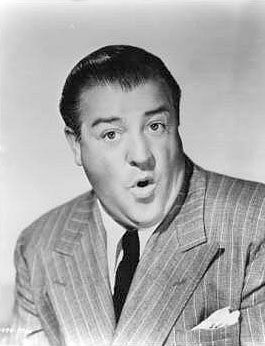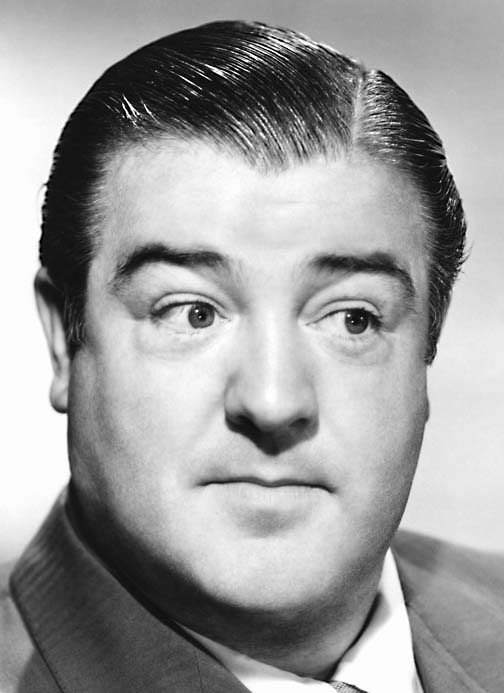Lou Costello (Louis Francis Cristillo)

As a young man, Lou Costello was a great admirer of silent movie great Charlie Chaplin, and in 1927 Costello went to Hollywood to become an actor, but could only find work as a laborer or extra at Metro-Goldwyn-Mayer and Warner Brothers, including MGM’s The Fair Co-Ed (1927). His athletic skill brought him occasional work as a stunt man, notably in The Trail of ’98 (1928). He can also be spotted sitting ringside in the Laurel and Hardy film The Battle of the Century (1927). In 1930, discouraged by his lack of success, he hitchhiked back home but ran out of money in Saint Joseph, Missouri during the Great Depression. There he changed his stage name to “Costello”, after actress Helene Costello, and convinced a local burlesque theater owner to let him perform, taking the stage as a Dutch comic. (“Dutch” was a corruption of “Deutsche,” and the comic performed with a German accent.) Soon after, he went back to New York and began working in vaudeville and then burlesque on the Mutual Burlesque wheel. Lou Costello crossed paths with a talented straight man named Bud Abbott. In 1935 they first worked together at the Eltinge Theater on 42nd Street when Costello’s partner failed to show. Abbott and Costello formally teamed up in 1936. Reportedly, their first disagreement was over a booking in a minstrel show at the Steel Pier in Atlantic City. Lou Costello wanted to take the gig, but Abbott was resistant. Costello offered to give Abbott a larger split of their salary, and Abbott agreed. Years later, in the flush of their Hollywood success, Costello reversed the salary split, 60-40 in his favor.
Abbott and Costello were signed by the William Morris talent agency, which succeeded in landing them featured roles and national exposure on The Kate Smith Hour, a popular variety show, in 1938. The team’s signature routine, “Who’s On First?,” made its radio debut on Smith’s show that year. Many of the team’s sketches were further polished by John Grant, who was hired soon after the team joined the radio show. Their success on the Smith program led to their appearance in a Broadway musical in 1939, The Streets of Paris. The following year they were signed to a movie contract with Universal Pictures. They only had supporting roles in their first picture, One Night in the Tropics (1940), but stole the film with their classic routines, including a much-shortened version of “Who’s On First?” (a more complete version was performed in The Naughty Nineties, released in 1945). The team’s breakthrough picture, however, was Buck Privates, released early in 1941. They immediately became the top-ranking comedy stars in Hollywood. Most moviegoers had never seen the duo’s burlesque routines, and so their dated but hilarious material seemed fresh.
The duo made 36 films between 1940 and 1956, and were among the most popular and highest-paid entertainers in the world during World War II. Among their most popular films are Buck Privates, Hold That Ghost, Who Done It?, Pardon My Sarong, The Time of Their Lives, Buck Privates Come Home, Abbott and Costello Meet Frankenstein and Abbott and Costello Meet the Invisible Man. The team also appeared on radio throughout the 1940s. On October 8, 1942, the team launched their own weekly show on NBC sponsored by Camel cigarettes. In March 1943, after completing Hit the Ice, Costello had an attack of rheumatic fever and was unable to work for six months. On November 4 of that year he returned to the team’s popular radio show, but a tragic event overshadowed his comeback. Upon arriving at the NBC studio, Lou received word that his infant son, Lou Jr., had accidentally drowned in the family pool. During an afternoon nap, the baby worked loose one of the slats on his crib, and climbed out and fell into the pool, unnoticed by the nanny. The baby (‘Little Butch’) was just two days short of his first birthday. Lou had asked his wife to keep Butch up that night so the boy could hear his father on the radio for the first time. Rather than cancel the broadcast, Lou said, “Wherever he is tonight, I want him to hear me,” and went on with the show. No one in the audience knew of the death until after the show when Bud Abbott explained the events of the day, and how the phrase “The show must go on” had been epitomized by Lou that night. Costello’s close friend, Maxene Andrews of the The Andrews Sisters said that his entire demeanor changed after the tragic loss of his son, saying, “He didn’t seem as fun-loving and as warm… He seemed to anger easily… there was a difference in his attitude.”
It was about this time that serious cracks began to appear in the relationship between Abbott and Costello. In 1945, when Costello fired a domestic servant, and Abbott hired her, Lou Costello announced that he would no longer work with Abbott. However, they were still under contract to Universal, and required to complete two movies in 1946. They did so, filming Little Giant and The Time of Their Lives, both in which they barely appeared on screen together. By then, they were not speaking to one another off-camera. A year later, Abbott reached out to heal their relationship, suggesting that the foundation Costello had founded be named the Lou Costello Jr. Youth Foundation, which touched Lou Costello deeply. Their radio program moved to ABC (the former NBC Blue Network) from 1947 to 1949. In 1951 the duo became one of the rotating hosts of The Colgate Comedy Hour (Eddie Cantor, Martin and Lewis, and Bob Hope were among the others) and the following year they inaugurated their own situation comedy, The Abbott and Costello Show. Costello owned the half-hour series, with Abbott working on salary. The show, which was loosely adapted from their radio program, ran for two seasons, from 1952 to 1954, but found a new life as syndicated reruns.
They were forced to withdraw from Fireman Save My Child in 1954 due to Costello’s poor health—he had been plagued by heart problems all his life due to a childhood bout of rheumatic fever—and were replaced by lookalikes Hugh O’Brian and Buddy Hackett. They were dropped by Universal the following year. Lou Costello was surprised and honored by Ralph Edwards on NBC’s This Is Your Life in 1956. By the mid-1950s Abbott and Costello films were no longer box-office gold, and after a failure to come to terms with the team, Universal dropped their movie contract in 1955. With radio, film, and television vehicles, they suffered from overexposure, and the team of Dean Martin and Jerry Lewis were the new hot entertainment commodity that Abbott and Costello had been a decade earlier. In 1956, after troubles with the Internal Revenue Service forced both men to sell their large homes and the rights to some of their films, Abbott and Costello made their final film together, an independent production called Dance With Me, Henry. The film was a box-office disappointment and received mixed critical reviews. Abbott and Costello dissolved their partnership in 1957 (this time amicably), and Costello then pursued a solo stand up career, including stints in Las Vegas, and sought film projects for himself. He appeared several times on Steve Allen’s fledgling, The Tonight Show but most often in variations of his old routines, with Louis Nye or Tom Poston taking on the straight man role. Lou Costello sought to be known as something other than the funny fat man in the baggy clothes, and played a dramatic role on television’s Wagon Train.
After making the film, The 30 Foot Bride of Candy Rock, Lou Costello died of a heart attack at Doctors’ Hospital in Beverly Hills on March 3, 1959, three days before his 53rd birthday. A funeral Mass was held at his parish, St. Francis de Sales Catholic Church in Sherman Oaks. He is interred at the Calvary Cemetery in East Los Angeles, California. His last words as reported in the March 4, 1959 Los Angeles Times and Los Angeles Evening Mirror News were “I think I’ll be more comfortable,” according to a private nurse who was the only person in the room with him at the time. The widely reported claim that he died in the presence of friends and that his last words were actually “that was the best ice-cream soda I ever tasted” appears to be incorrect, although the Los Angeles Times and Los Angeles Evening Mirror News articles both note Costello eating a strawberry ice-cream soda earlier that day in the presence of his manager Eddie Sherman, making it possible that the quoted statement was uttered at that time. Anne, his wife, was at his side most of the day, but was sent home by her assuring husband only an hour before his death at 3:55pm. Later that same year on December 5, Lou’s widow Anne died from an apparent heart attack at age 47.
Born
- March, 06, 1906
- USA
- Paterson, New Jersey
Died
- March, 03, 1959
- USA
- Los Angeles, California
Cause of Death
- heart attack
Cemetery
- Calvary Cemetery
- Los Angeles, California
- USA



